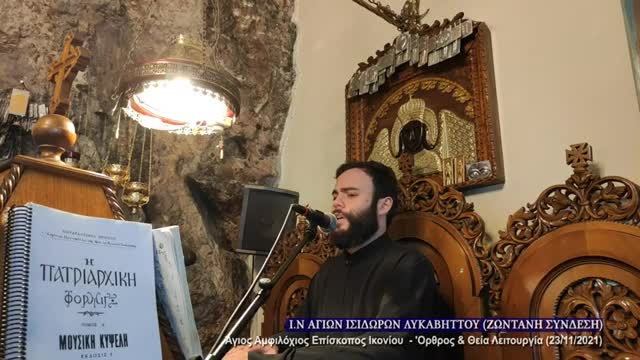Premium Only Content

November 23, 2022, St. Amphilochius, Bishop of Iconium | Greek Orthodox Divine Liturgy
Saint Amphilochius, who was born in Cappadocia, shone forth in asceticism and divine knowledge even from his youth. He was consecrated Bishop of Iconium in 341, he struggled courageously against the blasphemies of Eunomius, Macedonius the enemy of the Holy Spirit, and the followers of Arius. He was present at the Second Ecumenical Council of the 150 Fathers, which took place in Constantinople, convoked during the reign of Theodosius the Great in the year 381. In 383 Amphilochius wished to persuade the Emperor Theodosius to forbid the Arians from gathering in Constantinople and to commit the churches to the Orthodox, but the Emperor was reluctant to do such a thing. The next time that Amphilochius entered the palace, he addressed Theodosius with proper honour, but slighted his young son Arcadius in his presence. Theodosius was indignant, and said the dishonour shown to his son was equally an insult to himself. To this Saint Amphilochius answered that as he would not suffer an insult to his son, so he ought to believe that God is wroth with those who blaspheme His Only-begotten. Saint Theodosius understood and admired Amphilochius' ingenious device, and he issued the desired edict in September of the same year. Saint Amphilochius, having reached deep old age, reposed in peace about the year 395. Saint Basil the Great wrote many letters to Saint Amphilochius, his friend and Fellow champion of the Faith, and at his request wrote his treatise On the Holy Spirit, which besides demonstrating the divinity of the Holy Spirit and His equality with the Father and the Son, defends the Church's unwritten ancient traditions, such as making the sign of the Cross, turning towards the East in prayer, no kneeling on Sunday, and so forth.
Watch live from the Greek Orthodox Church of Saint Isidoroi at Lycabettus Hill, the Matins/Orthros and the Divine Liturgy. The small church of Saint Isidoroi belongs to the Holy Archdiocese of Athens and is located on the west side of Lycabettus Hill in Athens, built inside the largest cave on the hill. According to tradition, this cave was a place of ascetic life of the Christians of the first centuries.
-
 23:18
23:18
Crowder Bits
7 hours agoDebunked: John Oliver's Outrageous Lies About Trump 2.0
79.3K37 -
 1:59:18
1:59:18
Russell Brand
4 hours agoThe Battle for Truth: Gregg Hurwitz on Myth, Power & Cultural Control – SF540
100K43 -
 2:00:46
2:00:46
Steven Crowder
6 hours agoFight! Major Lawsuit Announcement...
492K280 -
 19:50
19:50
Clownfish TV
16 hours agoFacebook FIRED 'Underperforming' Employees and They're P*SSED!
10.7K7 -
 8:34
8:34
Dr. Nick Zyrowski
27 days agoWhat Happens If You Take High Dose NAC ( N-Acetyl Cysteine) For 14 Days
13.9K12 -
 25:31
25:31
The Boomer Effect
5 hours agoPotential Employees and Employers: What You Need to Know For The Hire
7.63K1 -
 2:55:25
2:55:25
The Dana Show with Dana Loesch
3 hours agoTRUMP AND ELON MUSK DEFEND DOGE | The Dana Show LIVE On Rumble!
27.8K3 -
 59:31
59:31
Grant Stinchfield
3 hours ago $2.81 earnedThe Heist of Fort Knox That President Trump Thwarted
32.2K21 -
 1:58:34
1:58:34
The Charlie Kirk Show
3 hours agoTHE CHARLIE KIRK SHOW IS LIVE 02.19.25
87.9K14 -
 1:00:47
1:00:47
The Dan Bongino Show
6 hours agoWhat Did Zelensky Know? When Did He Know It? (Ep. 2426) - 02/19/2025
655K1.15K